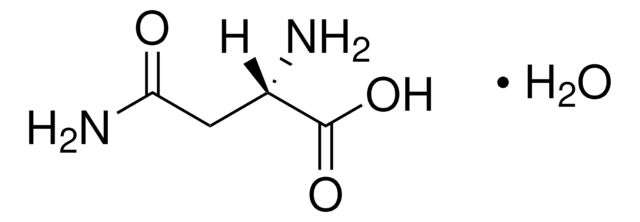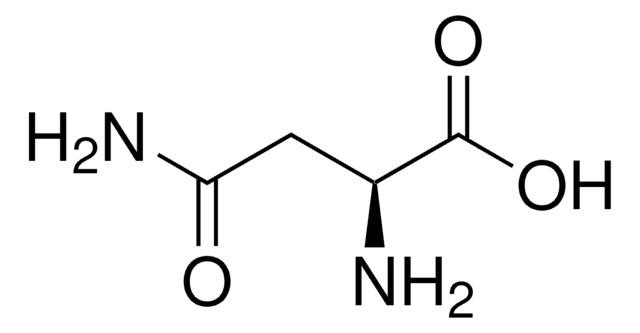1.01566
L-Asparagine monohydrate
for biochemistry
Synonym(s):
L-Asparagine monohydrate, Asparaginic acid semiamide, Asn
About This Item
Recommended Products
Quality Level
form
solid
pH
4.0-5.5 (20 °C, 20 g/L in H2O)
mp
215-217 °C (decomposes)
solubility
22 g/L
bulk density
530 kg/m3
storage temp.
2-30°C
InChI
1S/C4H8N2O3.H2O/c5-2(4(8)9)1-3(6)7;/h2H,1,5H2,(H2,6,7)(H,8,9);1H2/t2-;/m0./s1
InChI key
RBMGJIZCEWRQES-DKWTVANSSA-N
Related Categories
Application
- Chiral Resolution and Amino Acid Racemase Applications: L-Asparagine monohydrate has been utilized in the immobilization of amino acid racemases complemented with preferential crystallization process for enhanced chiral resolutions (Carneiro et al., 2020).
- Electro-optical Property Studies: L-Asparagine monohydrate can be used to prepare growth crystals to study its electro-optical properties, particularly in noncentrosymmetric crystal environments. (Shkir et al., 2015).
Analysis Note
Identity (IR-spectrum): passes test
Identity (specific rotation): passes test
Appearance: white to almost white crystalline powder or colorless crystals
Appearance of solution (20 g/l, CO₂-free water): clear and colorless
Spec. rotation (α 20/D, 100 g/l, hydrochloric acid 3 mol/l, calc. on dried substance): +33.7 to +36.0
Chloride (Cl): ≤ 200 ppm
Sulfate (SO₄): ≤ 200 ppm
As (Arsenic): ≤ 5 ppm
Ca (Calcium): ≤ 10 ppm
Co (Cobalt): ≤ 5 ppm
Fe (Iron): ≤ 5 ppm
K (Potassium): ≤ 5 ppm
Mg (Magnesium): ≤ 5 ppm
Na (Sodium): ≤ 50 ppm
Pb (Lead): ≤ 10 ppm
Zn (Zinc): ≤ 5 ppm
Ninhydrin-positive substances (LC)(Aspartic acid): ≤ 0.5 %
Ninhydrin-positive substances (LC)(any other ninhydrin-positive impurity): ≤ 0.3 %
Ninhydrin-positive substances (LC) (ammonium (570 nm)): ≤ 0.02 %
Ninhydrin-positive substances (LC)(total impurities): ≤ 0.8 %
Loss on drying (130 °C, 3 h): 10.5 - 12.5 %
Storage Class
11 - Combustible Solids
wgk_germany
WGK 1
flash_point_f
Not applicable
flash_point_c
Not applicable
Certificates of Analysis (COA)
Search for Certificates of Analysis (COA) by entering the products Lot/Batch Number. Lot and Batch Numbers can be found on a product’s label following the words ‘Lot’ or ‘Batch’.
Already Own This Product?
Find documentation for the products that you have recently purchased in the Document Library.
Customers Also Viewed
Our team of scientists has experience in all areas of research including Life Science, Material Science, Chemical Synthesis, Chromatography, Analytical and many others.
Contact Technical Service

